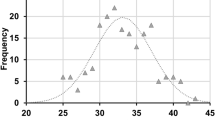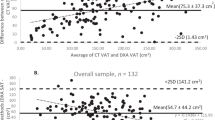Abstract
Background/objectives
To investigate the relationship between the cross-sectional visceral adipose tissue (VAT) areas at different anatomic sites and the total VAT volume in a healthy Chinese population using quantitative computed tomography (QCT), and to identify the optimal anatomic site for a single slice to estimate the total VAT volume.
Subjects/methods
A total of 389 healthy Chinese subjects aged 19–63 years underwent lumbar spine QCT scans. The cross-sectional area of total adipose tissue and VAT were measured using the tissue composition module of the software (QCT Pro, Mindways) at each intervertebral disc level from T12/L1 to L5/S1, as well as at the umbilical level. The total VAT volume was defined as the fat areas multiplied by the height of vertebral body for all six slices. Statistical analysis was performed to determine the correlation between single-slice VAT areas and the total VAT volume. Moreover, the optimal anatomic site for a single slice to estimate the total VAT volume was identified by multiple regression analysis.
Results
The cross-sectional area of VAT and subcutaneous adipose tissue (SAT) measured at each anatomic site was all highly correlated with the total VAT volume and the total SAT volume (r = 0.89–0.98). Additionally, the VAT area measured at the L2/L3 level showed the strongest correlation with the total VAT volume (r = 0.98, P < 0.001). Covariates including age, gender, BMI, waist, and hypertension make a slight effect on the prediction of the total VAT volume.
Conclusion
It is feasible to perform measurements of VAT area on a single slice at L2/L3 level for estimating the total VAT volume.
This is a preview of subscription content, access via your institution
Access options
Subscribe to this journal
Receive 12 print issues and online access
$259.00 per year
only $21.58 per issue
Buy this article
- Purchase on Springer Link
- Instant access to full article PDF
Prices may be subject to local taxes which are calculated during checkout




Similar content being viewed by others
References
Tchernof A, Després J-P. Pathophysiology of human visceral obesity: an update. Physiol Rev. 2013;93:359–404.
Irlbeck T, Massaro J, Bamberg F, O’Donnell C, Hoffmann U, Fox C. Association between single-slice measurements of visceral and abdominal subcutaneous adipose tissue with volumetric measurements: the Framingham Heart Study. Int J Obes. 2010;34:781–7.
Wang F, Wu S, Song Y, Tang X, Marshall R, Liang M, et al. Waist circumference, body mass index and waist to hip ratio for prediction of the metabolic syndrome in Chinese. Nutr Metab Cardiovas. 2009;19:542–7.
Shen W, Punyanitya M, Wang Z, Gallagher D, St-Onge MP, Albu J, et al. Visceral adipose tissue: relations between single-slice areas and total volume. Am J Clin Nutr. 2004;80:271–8.
Oda E. New criteria for ‘obesity disease’ in Japan. Circ J. 2006;70:150.
Sottier D, petit JM, Guiu S, Hamza S, Benhanmiche H, Hillon P, et al. Quantification of the visceral and subcutaneous fat by computed tomography: interobserver correlation of a single slice technique. Diagn Interv Imaging. 2013;94:879–84.
Wang L, Wang W, Xu L, Cheng X, Ma Y, Liu D, et al. Relation of visceral and subcutaneous adipose tissue to bone mineral density in Chinese women. Int J Endocrinol. 2013;2013:378632.
Kuk J, Church T, Blair SN, Ross R. Does measurement site for visceral and abdominal subcutaneousadipos tissue alter association with the metabolic syndrome? Diabetes Care. 2006;29:679–84.
Maislin G, Ahmed MM, Gooneratne N, Thorne-Fitzgerald M, Kim C, Teff K, et al. Single slice vs. volumetric mr assessment of visceral adipose tissue—reliability and validity among the overweight and obese. Obesity. 2012;20:2124–32.
Nazare JA, Smith JD, Borel AL, Haffner SM, Balkau B, Ross R, et al. Ethnic influences on the relations between abdominal subcutaneous and visceral adiposity, liver fat, and cardiometabolic risk profile: the International Study of Prediction of Intra-Abdominal Adiposity and Its Relationship With Cardiometabolic Risk/Intra-Abdominal Adiposity. Am J Clin Nutr. 2012;96:714–26.
Udupa JK, LeBlanc VR, Zhuge Y, Imielinska C, Schmidt H, Currie LM, et al. A framework for evaluating image segmentation algorithms. Comput Med Imaging Graph. 2006;30:75–87.
Steiger JH. Tests for comparing elements of a correlation matrix. Psychol Bull. 1980;87:245–61.
Ryo M, Kishida K, Nakamura T, Yoshizumi T, Funahashi T, Shimomura I. Clinical significance of visceral adiposity assessed by computed tomography: a Japanese perspective. World J Radiol. 2014;6:409–16.
Jia WP, Lu JX, Xiang KS, Bao YQ, Lu HJ, Chen L. Prediction of abdominal visceral obesity from body mass index, waist circumference and waist-hip ratio in Chinese adults: receiver operating characteristic curves analysis. Biomed Environ Sci. 2003;16:206–11.
Demerath EW, Shen W, Lee M, Choh AC, Czerwinski SA, Siervogel RM, et al. Approximation of total visceral adipose tissue with a single magnetic resonance image. Am J Clin Nutr. 2007;85:362–8.
Schweitzer L, Geisler C, Pourhassan M, Braun W, Glüer CC, Bosy-Westphal A, et al. What is the best reference site for a single MRI slice to assess whole-body skeletal muscle and adipose tissue volumes in healthy adults? Am J Clin Nutr. 2015;102:58–65.
Tong Y, Udupa JK, Torigian DA. Optimization of abdominal fat quantification on CT imaging through use of standardized anatomic space: a novel approach. Med Phys. 2014;41:063501.
Udupa JK, Odhner D, Zao L, Tong Y, Matsumoto MMS, Ciesielski KC, et al. Body-wide hierarchical fuzzy modeling, recognition, and delineation of anatomy in medical images. Med Image Anal. 2014;18:752–71.
Acknowledgements
The foundation from the National Natural Science Found of China (No. 81401407), Beijing Bureau of Health 215 Program (No. 2009-2-03) and Capital Health Development Research Program (No. 2014-2-1122).
Author information
Authors and Affiliations
Corresponding author
Ethics declarations
Conflict of interest
The authors declare that they have no conflict of interest.
Electronic supplementary material
Rights and permissions
About this article
Cite this article
Cheng, X., Zhang, Y., Wang, C. et al. The optimal anatomic site for a single slice to estimate the total volume of visceral adipose tissue by using the quantitative computed tomography (QCT) in Chinese population. Eur J Clin Nutr 72, 1567–1575 (2018). https://doi.org/10.1038/s41430-018-0122-1
Received:
Revised:
Accepted:
Published:
Issue Date:
DOI: https://doi.org/10.1038/s41430-018-0122-1
This article is cited by
-
Assessment of whole-body and regional body fat using abdominal quantitative computed tomography in Chinese women and men
Lipids in Health and Disease (2024)
-
Change in abdominal obesity after colon cancer surgery – effects of left-sided and right-sided colonic resection
International Journal of Obesity (2024)
-
CT analysis of thoracolumbar body composition for estimating whole-body composition
Insights into Imaging (2023)
-
Abdominal adipose tissue and type 2 diabetic kidney disease: adipose radiology assessment, impact, and mechanisms
Abdominal Radiology (2023)
-
Visceral adiposity and respiratory outcomes in children and adults: a systematic review
International Journal of Obesity (2022)



